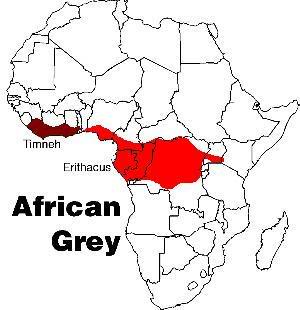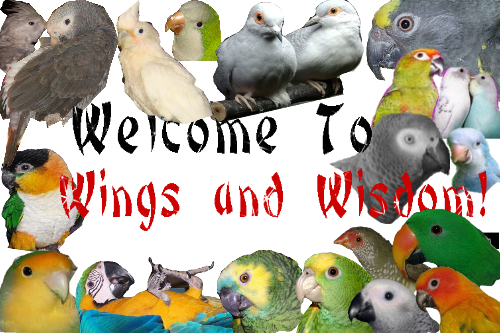The Congo African Grey
Page 1 of 1
 The Congo African Grey
The Congo African Grey
The Congo African Grey - (Psittacus erithacus erithacus.) They are the nominate species of the African Greys.
Average Weight - Between 350 and 650 grams and from 34cm to 38cm tall. Genetics, original region and sex will play a big roll on how big or small your grey will be.
Range – Congo African Greys are endemic to primary and secondary rainforests of West and Central Africa. They are found from the Ivory Coast to Western Kenya, Northwest Tanzania, Southern Democratic Republic of the Congo (DRC) and Northern Angola.

Status – The Congo African grey is listed as Nearly Threatened. In the United states, if you buy a young bird it was bread in captivity thanks to the Convention on International Trade in Endangered Species, (CITES), which makes it illegal to import wild greys into North America. It is still legal to import them in Europe, but conservation groups like the World Parrot Trust are working to change that.
History - For over 4000 years the African Grey has been kept as a prized pet. The Egyptians very well may have been the first to keeps these birds as pets and they are depicted in many of their hieroglyphics. The Greeks and Romans also treasured them as pets. King Henry VIII kept one, as did many other European royalties. One kept is reported to have learned to say, “God Save The Queen.”
The Congo, due to its high intelligence level, needs much more time and attention than some other parrot species. They have the IQ level of a 5-year-old, and are the emotional equivalent of a 2-year-old, making them somewhat demanding.
They are also known for being a one-person bird, so they are not a bird that should be expected to be a family pet. With proper socialization they can enjoy the company of others, but they bond very closely to one person…the “chosen” person. There is also a chance that when a grey hits sexual maturity they will switch their chosen person to another family member. Some say there is a greater percentage of Male greys that do this verses Females but there is no hard evidence of this. Switching people could be due to the fact that in the wild the male greys will leave the family flock to find a new flock, where as the females stay with the family. Proper socialization is key to keep this from happening.
The Congo is known for being neurotic, many times being fearful of new toys, furniture, people, and situations. These phobic behaviors can lead to feather destruction or plucking. This alone may be the biggest reason for socialization. There is some research that shows wild caught greys have an almost zero occurrence of feather plucking. Wild caught parrots go through the closest thing to hell on Earth during the entire ordeal of capture and exporting, and yet they seem to be the most well adjusted once settled in. This is thought to be because they were well socialized by their parents and are able to handle such a traumatic experience. On the other side, human raised greys are one of the most likely to pluck themselves, which raises the question “What are we doing wrong?” One theory is that Congo Greys stay with the parents for almost a year before they become fully independent, and have a network of adult Greys that watch over them. In captivity they are taken from what they have known as their family flock and placed into a new flock, and many times they no longer get the guidance they need. Am I saying that feather plucking is the owner’s fault? No, this is just a theory that has been raised that does make a lot of sense and could be the reason for many plucking cases.
The most notable characteristic trait of the African Grey is their amazing speech capacity. Many Greys can have a vocabulary of over 1000 words. Not only does the grey learn words and fraises but they also use a human voice. Amazons are a close second with talking ability and clarity, but most do not have the voice down pact like the Greys. The most notable of the Greys is Alex, the research subject of Dr. Irene Peperburg. He brought to light that parrots, Greys especially, are capable of cognitive speech. He was able to count objects up to 6 and knew the concept of zero. In one video clip, Dr. Peperburg gave him a peace of corn on the cob and he said “soft corn”, which was his name for fresh corn. Dr. Irene went on to say the he referred to dried corn as “rock corn”, and then Alex interrupted her and said “Cold”. “Yes, cold” she said and explained to him that it was strait out of the refrigerator. The ability to say things in that capacity shows that the Grey’s speech is not just mindless mimicry, but understanding what is being said. With that said though, not all Greys will talk. Some become what is know in the parrot world as “closet talkers”, where they have impressive vocabularies but will never utter a word of it in front of someone. Closet talkers wait till they think no one can hear them and the chat way to themselves. Still other Greys will never speak at all. This is why people should never buy any bird because they want a pet that can talk, because you would be surely disappointed.
Average Weight - Between 350 and 650 grams and from 34cm to 38cm tall. Genetics, original region and sex will play a big roll on how big or small your grey will be.
Range – Congo African Greys are endemic to primary and secondary rainforests of West and Central Africa. They are found from the Ivory Coast to Western Kenya, Northwest Tanzania, Southern Democratic Republic of the Congo (DRC) and Northern Angola.

Status – The Congo African grey is listed as Nearly Threatened. In the United states, if you buy a young bird it was bread in captivity thanks to the Convention on International Trade in Endangered Species, (CITES), which makes it illegal to import wild greys into North America. It is still legal to import them in Europe, but conservation groups like the World Parrot Trust are working to change that.
History - For over 4000 years the African Grey has been kept as a prized pet. The Egyptians very well may have been the first to keeps these birds as pets and they are depicted in many of their hieroglyphics. The Greeks and Romans also treasured them as pets. King Henry VIII kept one, as did many other European royalties. One kept is reported to have learned to say, “God Save The Queen.”
The Congo, due to its high intelligence level, needs much more time and attention than some other parrot species. They have the IQ level of a 5-year-old, and are the emotional equivalent of a 2-year-old, making them somewhat demanding.
They are also known for being a one-person bird, so they are not a bird that should be expected to be a family pet. With proper socialization they can enjoy the company of others, but they bond very closely to one person…the “chosen” person. There is also a chance that when a grey hits sexual maturity they will switch their chosen person to another family member. Some say there is a greater percentage of Male greys that do this verses Females but there is no hard evidence of this. Switching people could be due to the fact that in the wild the male greys will leave the family flock to find a new flock, where as the females stay with the family. Proper socialization is key to keep this from happening.
The Congo is known for being neurotic, many times being fearful of new toys, furniture, people, and situations. These phobic behaviors can lead to feather destruction or plucking. This alone may be the biggest reason for socialization. There is some research that shows wild caught greys have an almost zero occurrence of feather plucking. Wild caught parrots go through the closest thing to hell on Earth during the entire ordeal of capture and exporting, and yet they seem to be the most well adjusted once settled in. This is thought to be because they were well socialized by their parents and are able to handle such a traumatic experience. On the other side, human raised greys are one of the most likely to pluck themselves, which raises the question “What are we doing wrong?” One theory is that Congo Greys stay with the parents for almost a year before they become fully independent, and have a network of adult Greys that watch over them. In captivity they are taken from what they have known as their family flock and placed into a new flock, and many times they no longer get the guidance they need. Am I saying that feather plucking is the owner’s fault? No, this is just a theory that has been raised that does make a lot of sense and could be the reason for many plucking cases.
The most notable characteristic trait of the African Grey is their amazing speech capacity. Many Greys can have a vocabulary of over 1000 words. Not only does the grey learn words and fraises but they also use a human voice. Amazons are a close second with talking ability and clarity, but most do not have the voice down pact like the Greys. The most notable of the Greys is Alex, the research subject of Dr. Irene Peperburg. He brought to light that parrots, Greys especially, are capable of cognitive speech. He was able to count objects up to 6 and knew the concept of zero. In one video clip, Dr. Peperburg gave him a peace of corn on the cob and he said “soft corn”, which was his name for fresh corn. Dr. Irene went on to say the he referred to dried corn as “rock corn”, and then Alex interrupted her and said “Cold”. “Yes, cold” she said and explained to him that it was strait out of the refrigerator. The ability to say things in that capacity shows that the Grey’s speech is not just mindless mimicry, but understanding what is being said. With that said though, not all Greys will talk. Some become what is know in the parrot world as “closet talkers”, where they have impressive vocabularies but will never utter a word of it in front of someone. Closet talkers wait till they think no one can hear them and the chat way to themselves. Still other Greys will never speak at all. This is why people should never buy any bird because they want a pet that can talk, because you would be surely disappointed.
 Similar topics
Similar topics» Your Baby Grey is Coming Home
» my new baby congo grey
» Welcome to the African Grey Room
» African Grey Timnehs ready for a good home
» Stolen African Greys
» my new baby congo grey
» Welcome to the African Grey Room
» African Grey Timnehs ready for a good home
» Stolen African Greys
Page 1 of 1
Permissions in this forum:
You cannot reply to topics in this forum
